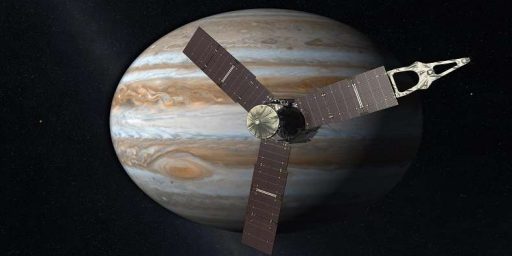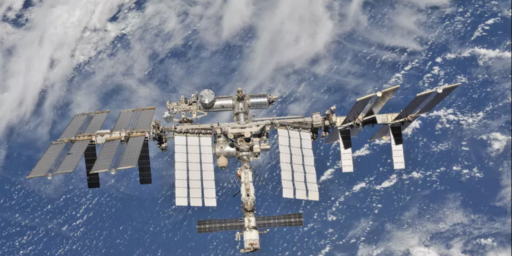The Solar Storm That Nearly Destroyed Civilization As We Know It
Just about two years ago, we dodged a bullet. We might not be so lucky next time.
Two years ago, we apparently came alarmingly close to an event that we could not have possibly avoided which would have had widespread devastating consequences:
On July 23, 2012, the sun unleashed two massive clouds of plasma that barely missed a catastrophic encounter with the Earth’s atmosphere. These plasma clouds, known as coronal mass ejections (CMEs), comprised a solar storm thought to be the most powerful in at least 150 years.
“If it had hit, we would still be picking up the pieces,” physicist Daniel Baker of the University of Colorado tells NASA.
Fortunately, the blast site of the CMEs was not directed at Earth. Had this event occurred a week earlier when the point of eruption was Earth-facing, a potentially disastrous outcome would have unfolded.
“I have come away from our recent studies more convinced than ever that Earth and its inhabitants were incredibly fortunate that the 2012 eruption happened when it did,” Baker tells NASA. “If the eruption had occurred only one week earlier, Earth would have been in the line of fire.”
This short video explains what nearly happened two years ago:
As NASA notes, Earth has been in the path of a CME before, but it’s never happened at a time when we are so dependent on technology:
Extreme solar storms pose a threat to all forms of high-technology. They begin with an explosion–a “solar flare”—in the magnetic canopy of a sunspot. X-rays and extreme UV radiation reach Earth at light speed, ionizing the upper layers of our atmosphere; side-effects of this “solar EMP” include radio blackouts and GPS navigation errors. Minutes to hours later, the energetic particles arrive. Moving only slightly slower than light itself, electrons and protons accelerated by the blast can electrify satellites and damage their electronics. Then come the CMEs, billion-ton clouds of magnetized plasma that take a day or more to cross the Sun-Earth divide. Analysts believe that a direct hit by an extreme CME such as the one that missed Earth in July 2012 could cause widespread power blackouts, disabling everything that plugs into a wall socket. Most people wouldn’t even be able to flush their toilet because urban water supplies largely rely on electric pumps.
Before July 2012, when researchers talked about extreme solar storms their touchstone was the iconic Carrington Event of Sept. 1859, named after English astronomer Richard Carrington who actually saw the instigating flare with his own eyes. In the days that followed his observation, a series of powerful CMEs hit Earth head-on with a potency not felt before or since. Intense geomagnetic storms ignited Northern Lights as far south as Cuba and caused global telegraph lines to spark, setting fire to some telegraph offices and thus disabling the ‘Victorian Internet.”
A similar storm today could have a catastrophic effect. According to a study by the National Academy of Sciences, the total economic impact could exceed $2 trillion or 20 times greater than the costs of a Hurricane Katrina. Multi-ton transformers damaged by such a storm might take years to repair.
“In my view the July 2012 storm was in all respects at least as strong as the 1859 Carrington event,” says Baker. ”The only difference is, it missed.”In February 2014, physicist Pete Riley of Predictive Science Inc. published a paper in Space Weather entitled “On the probability of occurrence of extreme space weather events.” In it, he analyzed records of solar storms going back 50+ years. By extrapolating the frequency of ordinary storms to the extreme, he calculated the odds that a Carrington-class storm would hit Earth in the next ten years.
The answer: 12%.
“Initially, I was quite surprised that the odds were so high, but the statistics appear to be correct,” says Riley. “It is a sobering figure.”
It is quite sobering indeed, not the least because there would apparently be very little advancing warning of such as solar storm, and little that we could do to prevent the damage to infrastructure that would result. Quite literally, tens of millions of people at least could find themselves living in a very different world in a very short period of time. Furthermore, even if we did have a fairly good idea that the Earth was about to become the target of a CME or similarly event that could cause disruption to communications, electronics, and other infrastructure, there’s nothing we could do to stop the event from happening. If we’re in the path, of a CME, we’re in its path and by the time we realized that fact there wouldn’t be much we could do about. The consequences would be whatever they would be.
That being said, there are steps that could be taken to deal with those consequences in advance. Power systems and critical infrastructure could be more heavily shielded against the electomagnetic pulses that accompany a CME that would cause the most damage. Canada took many of these steps after suffering damage from a much smaller event back in 1989, and one estimate prepared for the insurance industry estimates that it would take as little as $100 million to do the upgrades to the power grid in North America that would at least mitigate the damages from an event similar to what almost happened two years ago. Some might argue that this is a lot of money given the fact that we’re talking about something that is rated at “only” a 12% risk, but compared to the potential costs that would be incurred if such an event actually occurred, it seems like a bargain.







I know. Let’s impeach Obama. That will solve all our problems.
Destroying civilization as we know it? No way. Everyone would have get new things and someone would have to make them. Lots of jobs created and a technological boom when everyone had to ditch their old iPhone 3GS….
That is as long as enough people survived the Thunderdome…
Well, conservative dogma tells me that the scientific forecast of a future danger to civilization because of climate change is in reality a socialist plot to subvert capitalism, so I am definitely not going to buy the scenario of a future danger to civilization because of another natural event (a solar flare).
Besides the Bible tells us that the sun is merely a big light which God hung in the heavens , not a huge ball of incandescent gases undergoing constant thermoclear reactions, so talk of a solar flare is surely a lie out of the pit of hell. ( As the DC Court of Appeals tells us, one must interpret any document sentence by isolated sentence, without context or nuance, so there is no possibility of a non-literal interpretation of Genesis).
Tell me again why people should flock to the cities? Just a burp on the Sun and bam, back to the 1740s when cities were killing machines for the rural population. A killing machine that ran for millennia until sanitation (off-line), water purification (off-line), disease control (off-line) were able to keep people alive long enough to die of old age in cities.
On the other hand, should we worry about the hypothetical catastrophic effects of a gradual one degree increase in average global temperature when the sun could burn us all to a crisp with a little dyspepsia? All in all, cutting back on the imposed cost to combat fantasy effects of CAGW and spending power bill increases on hardening for something that has actually happened in the past seems like the better plan.
I expect to start seeing commercials for Solar Storm Survival Kits on Fox News any day now…unless of course President Obama makes a statement that he believes in solar storms.
$100 million seems like a ridiculously low-ball figure for hardening the electric grid in the U.S.
If it could be done for that amount, who would think that is a lot of money any more? That’s only 5% of the value of the LA Clippers.
I covered the top of my desk top computer with tin foil. In all seriousness I don’t really think people realize how catastrophic such an event would be to our modern civilization. I did a post on this over at The Moderate Voice yesterday. We are not prepared for such an event . as I said at TMV:
People in the less developed could survive while many if not most in the developed world would not.
@J-Dub: Actually that’s probably accurate. The high voltage transformers in the transmission system can be protected by a an inexpensive capacitor between the the transformer and ground.
“…another natural event (a solar flare).”
So are you implying that AGW, climate change is a natural event?
You have a day or more warning, so it’s relatively easy. Open the breakers. Do the unthinkable and shut the grid down for the duration of the event. There would still be damage, but about 90% less.
@JKB:
This isn’t either/or. Both threats are worth taking seriously. The cost of mitigating the threat from a major solar flare is apparently not terrible (let’s assume $100MM is low, but even 5x that isn’t scary) in comparison to the guesstimated cost of the event, and we can of course do it bit by bit. The same is true of mitigating climate change, but the longer we wait the more difficult it gets.
@Bob Beller:
If this is true, that sounds like a second-best solution (first-best being hardening the grid).
Hah! I knew there had to be at least one problem with the Terminator movie plot. So there’s definitely no way a liquid metal robot sheathed in a human skin could tunnel to the past through a wormhole singularity. Skynet would have been zapped by a solar flare long before it developed those capabilities.
@Bob Beller:
This in the country where we’re not even willing to tell people to get off the roads because a blizzard / hurricane / ice storm is coming? Where closing the schools on the basis of a forecast event (without waiting until people are actually getting hospitalized) is liable to cost you your job if it turns out not to be as bad as the maximum probable loss scenario?
If I’m doing the math right, this works out to about a 1.3% chance in any given year. Or, if you want the probability of a storm at least that big in the next N years, it’s something like
Years Probability
5 6%
10 12%
15 17%
20 23%
25 27%
30 32%
35 36%
40 40%
45 44%
50 47%
The expected wait until the next such event is 78 years, but the median is only 55 years.
(For the geeks out there, I’m assuming a homogenous Poisson process with a rate that makes the 10-year probability 0.12)
@DrDaveT: The school system here has won some, lost some.
We are in an area where snow is hard to predict and get it right. Sometimes it just fizzles out. I lsughed one year when the schools cslled off school and there was not one flake on the ground. One hour later we had 3 inches and ended up with six.
@Rob in CT: This has been the subject of discussions among some Congress members who realize the vulnerability of the electrical grid. A power station was attacked last year in California and showed just how vulnerable to a terrorist attack it is. One of these sun storms would be even worse. I have thought for the last few years that the Stimulus money could have helped pay for a project of that size and magnitude. Jobs and long term contracts would have helped the economy, made the electrical grid safer, and more efficient. Much of the power grid has been around since at least the mid 20th. Century. Contrast that project idea with some of the things that the “Stimulus” money actually went for. Such imperatives and urgent projects as a turtle tunnel, trees for wealthy neighborhoods, a Commmunist puppet show (Minnesota), a study of drunk mice, college twitter study, paying students at one college to keep diaries of their drinking and marijuana habits. The list could go on, but would take two hours to write. This is the 5th anniversary of the “Stimulus” program. There should be an independent study of it, to determine how many jobs were actually created, cost per job, where every penny went, its effects on the economy, and which legislators proposed each project.
“It looks like all those shovel ready jobs were not shovel ready” President Obama
“You spend a billion here and a billion there, it starts to add up” Senator Everett Dirksen